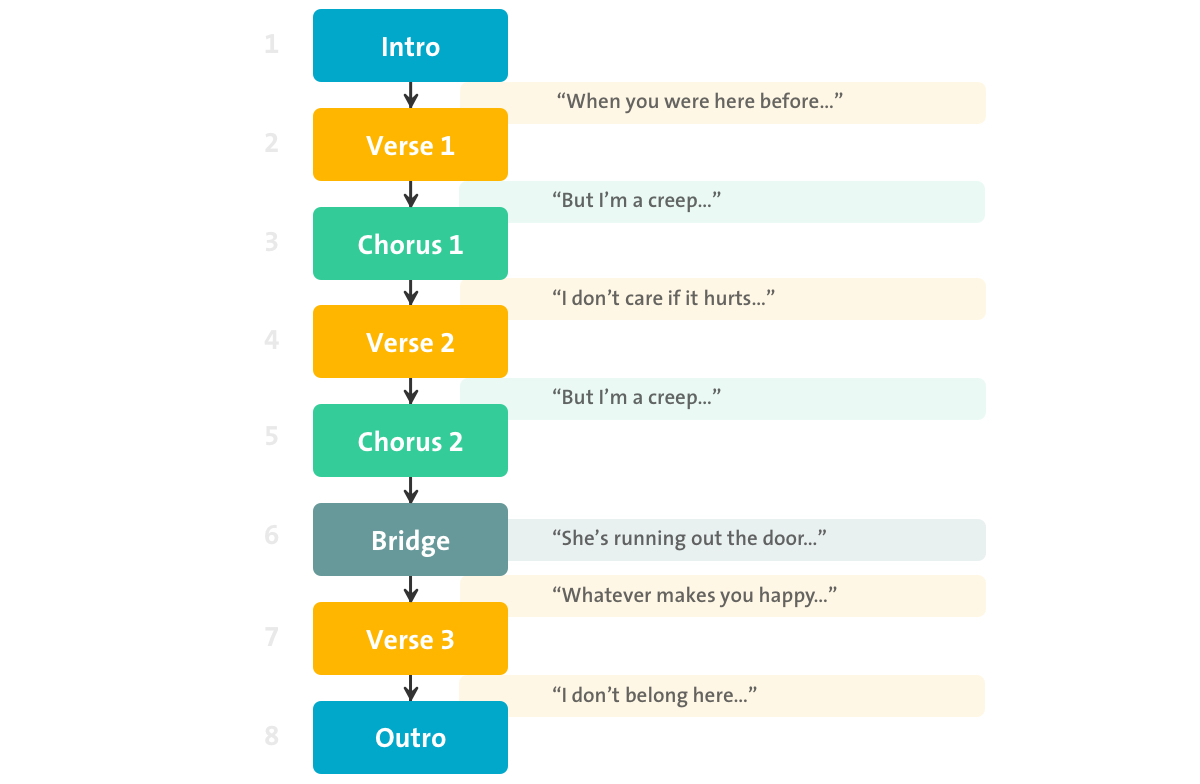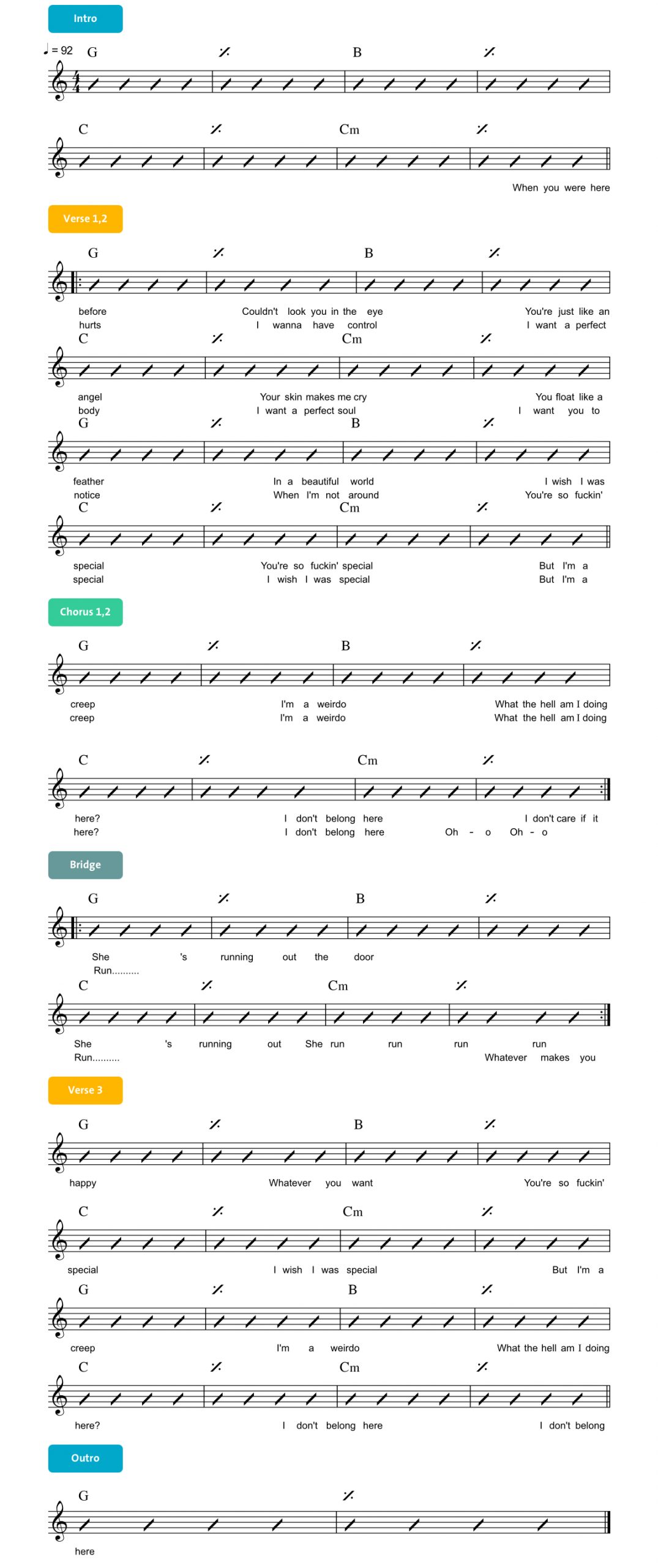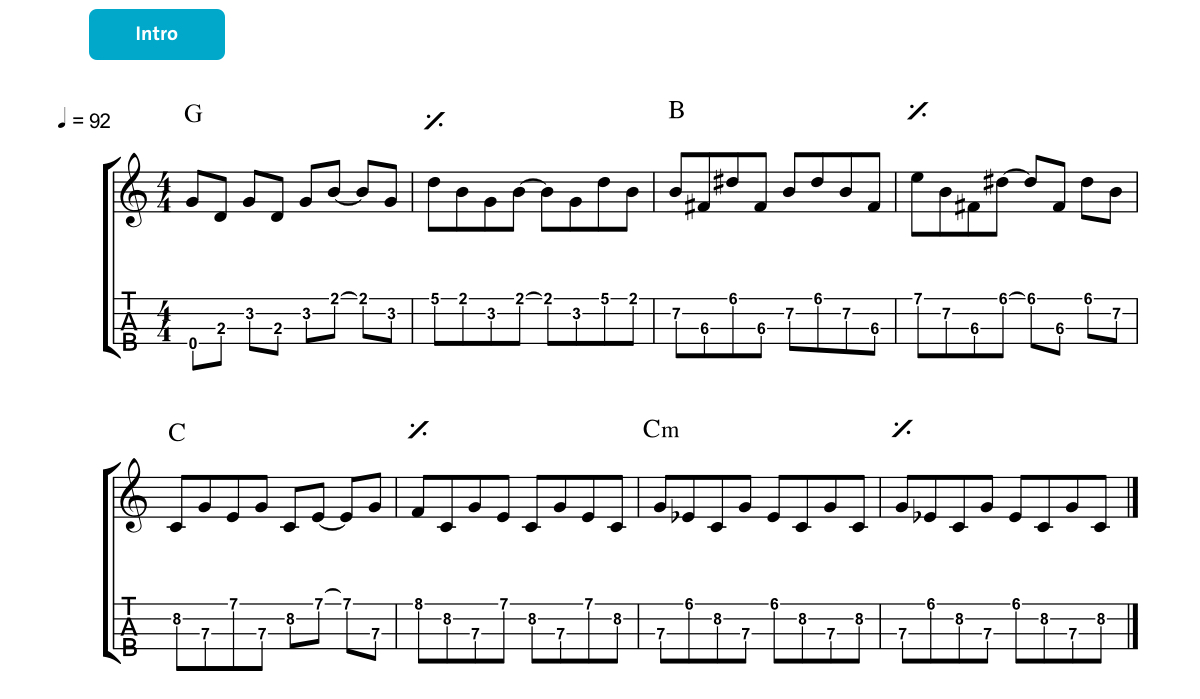Hey Radiohead fans! After publishing a guitar and piano edition dedicated to “Creep”, we can’t miss a chance to analyze this song for our ukulele players. So in this ukulele edition of our Songs Explained series, we’ll show you chord diagrams, video tutorials, and tablature for one of Radiohead’s biggest hits.
Estimated reading time: 10 minutes
In this blog post on how to play “Creep” by Radiohead on your ukulele you’ll find
Main takeaway
It’s always good to know what lies ahead. So we’ll start this blog post with a clear structure of “Creep”. You can compare it to a map that shows how the song progresses. It will help you on your journey through the Radiohead universe.
Since the chord diagrams of the song are pretty basic, we won’t be splitting this song up into levels like we usually do. The good news is that anyone can play it! But to keep the challenge alive, at the very end of the article we’ll just zoom in on the intro with notes and tabs, so that you can learn how to play it on your ukulele.
We’ll be wrapping this blog post up with some music theory which explains how Radiohead’s “Creep” can pull off looping only four chords and still sound like a very diverse and enriched composition. As always, you’ll be treated to some juicy trivia at the end. Now sit back and enjoy the ride.
Song structure
This song is a great example of what you can do by looping just four chords. By focusing on dynamic shades, lyrics and melodic lines in the vocal part, the track still sounds fresh and exciting even after four minutes.
The structure of “Creep” is like this:

Figure 1 – Song structure of “Creep”
Main chord progression
The song is built up out of four parts: Intro, Verse, Chorus and Bridge. The good news is that three of those consist of the same chord loop. The short Outro is played with only the G chord. Check out the figure below for the chord progression we’re talking about. With these four chords you can play the whole song from start till end.

Figure 2: The chord loop.
How to play “Creep”
In this part you’ll find:
– Chord diagrams
– Video tutorial
– Chord progression
– Chords & Lyrics
Chord diagrams
Let’s take a closer look at the basic shapes for the four chords, which you need to know to play Radiohead’s “Creep”. Let’s get started, shall we? In the figure below, you’ll find the chord diagrams we just mentioned.
Chord progression
This is where you can find the charts for all parts of the song, together with the explanation video. We’ll show you an example of how you can play certain parts of the song on your ukulele. So, let’s go!
As we explained before, the chord progression stays the same for almost all the parts of “Creep” by Radiohead. The only thing that is different is the amount of times you repeat the chord loop. Here is the chord progression for the Intro:

Figure 3 – Intro chord progression.
Our explanation video can help you to play this song! In the video for the Intro we play each chord on the first beat of each bar.
Here is the chord progression for the Verse:

Figure 4 – Verse chord progression.
For the Verse part, we again play each chord on the first beat of each bar.
Here is the chord progression for the Chorus:

Figure 5 – Chorus chord progression.
In the video for the Chorus part, we play each chord twice per bar: on the first beat and on the fourth beat.
Here is the chord progression for the Bridge:

Figure 6 – Bridge chord progression.
For the Bridge, we play each chord on every four beats of the bar: on the first, second, third and fourth beats. Meaning, the chords match with the metronome clicks.
Here is the chord progression for the Outro:

Figure 7 – Outro chord progression.
In the video for the Outro we play the G chord on the first beat of every bar.
Chords & lyrics
So what do you say? Shall we play the whole song? Here’s the chart for you. Keep in mind that the Verse and Chorus are repeated twice (you can see repetition signs there): Verse 1 – Chorus 1 – Verse 2 – Chorus 2. That’s why you see two lines of lyrics – the upper line for Chorus 1 and Verse 1; the lower line for Chorus 2 and Verse 2.
You can also see the repetition sign for the Bridge along with two lines of lyrics. So the eight bars of the Bridge are repeated twice. In general, the repetition sign is very handy in order to save a lot of space in the charts.

Figure 8 – Chords with lyrics “Creep” by Radiohead.
Pro. How to play Intro from “Creep” on ukulele
The guitar intro for this song is very significant, recognizable and sounds super cool, doesn’t it!? So, our dear ukulele lovers, we’ve prepared something for you. How about we teach you how to play this part on your ukulele? The intro has interesting elements of an arpeggio, which can help you to improve your picking and fingering techniques. Also, since it has quite a few octave jumps, it was quite a challenge for us to transcribe it for the ukulele. Let’s get started!
We’ve prepared some note charts for you, but if you can’t read notes, no worries, there’s also tablature. To make it easier for you to play, every two bars is based on a certain chord shape, reflecting the notes we play in this Intro. The shape for the G chord stays the same, as we played it before. For the B, C and Cm chords shapes, they become different – see the table below:
So, with these chord shapes in mind, play the Intro. You can find the note charts and tablatures below.

Figure 9 – Intro part.
Tips and tricks on how to practice efficiently
First, practice it slowly. Play two bars of each chord separately. For instance, play only the 1st and the 2nd bar of the G chord, then move to the 3rd and 4th bar of the B chord. Then try to connect these chords together by playing the 1st, 2nd, 3rd and 4th bars in a row. Do it as slowly as you feel comfortable with, gradually raising the speed to the original tempo.
Music theory
As you’ve already learned, “Creep” has four chords. These chords create a loop, which is repeated over and over again during the whole song. And it doesn’t sound monotonous at all, which is even cooler. Every time the loop resets, it creates a new movement. Let’s take a look at why these chords work so well together.
The chord progression:

Figure 10 – Chord loop for “Creep”.
G – is the I (tonic) chord of the song.
C – is the IV chord.
B is the chord of the III degree of G major. Usually on the III degree of major scales we have a minor chord. However, in this particular song, we have a B major chord, which can be considered as a secondary dominant – the dominant chord moving to an Em chord (VI degree of G). But this secondary dominant (B) doesn’t resolve to Em, it moves to a C chord.
At the end of the chord progression, the C (IV chord of the G major) turns into a C minor chord (IVmin), which is resolved back to the G chord. This cadence of IV minor – I chord is known as a minor plagal cadence. And as you have noticed already, it sounds amazing.
Trivia
“Creep” had such an impact on the career of Radiohead that you could say the track was the band’s catalyst – culturally and financially. The alternative rock stars could support themselves from the sales of the single, the album Pablo Honey, and all the covers that were made by big stars like Moby and Alanis Morissette.
Dark minded as Radiohead can be, they labeled the song not a blessing, but a curse. Thom Yorke shouted out in anger towards audiences that begged him to play the song, and the band refused to perform the track for years. In the end Radiohead even wrote a song about their hit “Creep”, and called it “My Iron Lung”.
An iron lung is a respirator mostly used on people that suffer from polio, because the disease paralyzes the lungs. The metaphor is pretty dark, since Radiohead states that “Creep” is their iron lung. It keeps the band alive financially, but it also forces them to create music in a certain style.
In the third verse of “My Iron Lung”, Thom Yorke sings: “This, this is our new song. Just like the last one, a total waste of time. My iron lung.” The approach is super metaphysical, which is Radiohead just being Radiohead. That of course doesn’t mean the song “Creep” itself isn’t worth playing. So, what are you waiting for? Grab your ukulele and show Thom Yorke you mean it.
Happy jamming!
By Kirill Dumchenko and Teo Lazarov.


